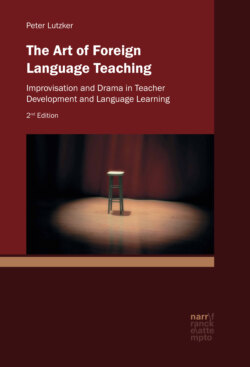Читать книгу The Art of Foreign Language Teaching - Peter Lutzker - Страница 28
На сайте Литреса книга снята с продажи.
1.3.6 Relevance for Teacher Training
ОглавлениеIn discussing his experiences with traditional teacher training, Rubin explains what he sees as inherent weaknesses in such programs. He argues that such programs may, in the end, actually prevent teachers from realizing their potentials:
…the usual teacher training program, both pre-service and in-service is often a liability. As the teachers tried to construct lesson staging, mood setting, and motivational activities, it became obvious their imaginative faculties had been blunted. They repeatedly sought advice on “acceptable methods.” When these requests were politely ignored, their apprehension over the need to invent rose sharply. Not only was the demand for originality threatening, but their natural aptitude for imagery, fantasy, and whimsy had been damaged by the prescriptive formulas ingrained during their professional preparation.117
Rubin sets himself the ambitious goal of designing an in-service program for teachers wherein they would be encouraged to develop artistic qualities which would enhance and enliven their teaching. A key initial element of this program involved first identifying and observing gifted teachers and postulating a series of attributes intrinsic to artistic teaching. A further decisive aspect was his recognition that a crucial step towards being able to work on developing such characteristics lay in the development of a creative attitude and state of mind which could become internalized. This required confronting the anxieties which often accompany such changes and developments:
Since creation involves a risk of failure, it sometimes generates anxiety. Can teachers acquire the psychological study safety essential to inventive behaviour? Can teachers learn to view the familiar in unfamiliar ways, to see possibilities in the seemingly impossible? In short, can the creative spirit be cultivated?118
He maintains that the fundamental change in attitudes which this may require for some teachers must be considered an indispensable part of their entire development. At the same time, he recognizes that this is a long-term process:
Since attitudes have a profound effect on teaching behaviour, it is curious that teacher training has so often ignored them. (…) First, we assume that attitudes and beliefs can be changed through mandate, exhortation, or lecture. Unfortunately, human impulse is made of firmer stuff. Beliefs run too deep to be easily swayed by words, whether printed or spoken. Usually they must be modified through the same processes by which they were formed – consistent experiences accumulated over time. (…) …the time allotted to a professional development activity is usually short, whereas the time required for authentic attitudinal change is usually long. It may take more time for teachers to develop faith in a technique than to learn its use.119
Whether such developments actually occur hinges on how deeply they are connected to the teacher’s own sentient life. He argues that the preoccupation in teacher education with what teachers should know often eclipses the essential aspect of what they actually feel, which he considers to be the underlying basis of what they later do. In this context, he quotes the philosopher Susanne Langer: “Where nothing is felt, nothing matters.”120
A further aspect which he sees as essential to in-service programs devoted to the development of artistry in teaching is the development of what he calls the capability of ‘collateral teaching’.121 By this he means the ways which outstanding teachers are able to work simultaneously towards multiple objectives, taking maximum advantage of possibilities to address primary and secondary goals at the same time, establishing links, drawing on latent resources, clarifying and reinforcing ideas in a highly expeditious manner. He contrasts the “over-simplicity” and “excessive plainness” of many lessons with the kind of intensity and “energized learning” which can occur when multiple opportunities are being used.122 He draws a comparison to illuminate what he means:
More than once, I have been struck by the parallel between master teachers, expert mechanics and those who are skilled in the kitchen. One cook washes the vegetables, then melts the butter, then seasons the roast – proceeding from task to task, a single step at a time. Another somehow does all three at once. The mediocre mechanic drains the engine oil, idly watching the liquid drip into a container. The expert one turns his attention elsewhere, lubricating one part and adjusting two others, before the draining is finished.123
Developing these abilities thus becomes another key element of his in-service program for teachers, requiring a heightening of the teacher’s perceptual capabilities, the development of a form of “multiple vision” and a cultivation of spontaneity enabling the teacher to react intuitively at the moment when such opportunities present themselves.
